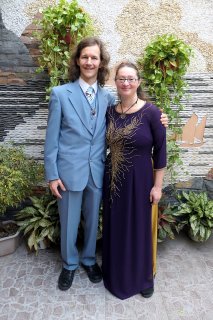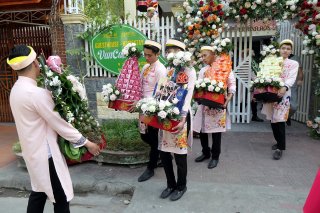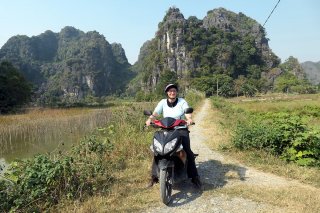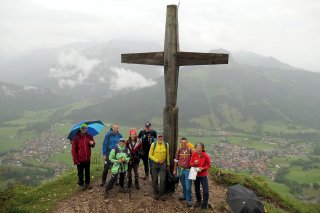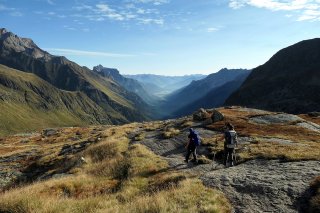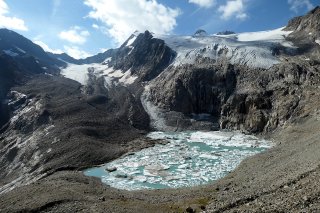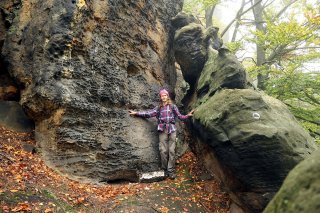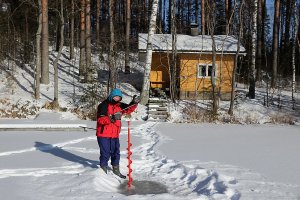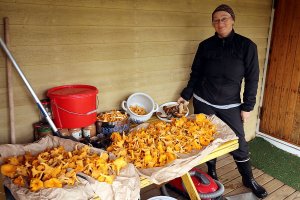Arto's Blog
Wedding in Vietnam and travels during the Corona year
Posted: 2020-12-23 17:07:00, Categories: Travel, Finland, Austria, Italy, Cycling, Germany, Hiking, Vietnam, 1324 words (permalink)Year 2020 has been unusual and affected the lives of everybody in many ways, including ours. Travelling is just one part of it but as it has been the main theme of this site for over 20 years it seems fitting to write about it also now. Some of our plans got cancelled but we still had several opportunities to get out and enjoy exploring new places as well as meeting family, friends and a few new people too. As the end of the year approaches and I haven't been active in writing during the year, what follows is a summary of the last 12 months packed in one article.
Quite exactly a year ago, in December 2019 we spent two weeks in northern Vietnam, mostly in and around Hai Phong. Normally we avoid trips that far for environmental reasons unless we have a minimum of 2-3 months to spend in the destination — which reduces the frequency of such trips quite naturally. This time we made an exception as an old school friend of mine got married and invited us to his wedding. As it later turned out, it was the last chance of travelling to distant lands for quite a long time.
The couple was Finnish-Vietnamese but the ceremonies mostly followed the local traditions. They were colourful, joyful, at times kitschy and thoroughly documented by a two-man video- and photographer team. We also took plenty of photos but due to the request of the couple won't publish any shots of them here. The host family took excellent care of us and other Finnish guests, including a day trip together to the nearby famous Halong Bay. Simultaneously it was a chance to meet and chat with old friends some of which I hadn't seen for the last 20 years. We all stayed in the same hotel and in addition to the wedding spent some time walking around in the city together.
During the second week Sandra and I headed out to the countryside, booked rooms in small guest houses and rented a small motorcycle for a few days. South-East Asia is for us an exotic but easygoing, tasty food and good mood destination. Vietnam was no exception to that and especially in the friendliness of the locals at the top end of the scale. What made the stay somewhat less enjoyable was the air pollution. Almost windstill days without rain made the otherwise postcard-like views constantly hazy and we both developed a light cough which healed again as soon as we left the country.
On the way back to Germany we stopped for three days in Dubai where we would have anyway needed to change the plane. There we sent a few CouchSurfing requests and got invited to stay with an Indian architect, a perfect match in a city filled with modern high-rise buildings and plenty more coming up. With its huge shopping malls and theme-park like attractions Dubai wasn't really our world, but interesting to explore for a couple of days. Our friendly and generous host gave us some local insight to the life there.
After that came winter and spring with cancellations and lockdowns, for us of course including plenty of day hikes on the nearby Alps. In June we were able to join our already over half a year in advance booked one week volunteer hiking guide training of the German Alpine Club DAV. It was the very first course of the summer which actually took place. Despite the rainy weather we had a good time and learned a lot in the motivated and welcoming small group lead by two excellent instructors.
Right after the hiking guide course we took advantage of the reopening of EU borders and drove to northern Italy to spend a long weekend at a mountain farm. A friend of ours from Munich takes care of the cows there every summer for a few weeks. That farm doesn't generally offer accommodation for tourists (unlike some others which do) but she is allowed to invite her friends there. Cottage life and excellent raw milk, of course. Cottage life continued in July in Finland by the lake Saimaa, where we stayed this time mainly at my aunt Pirkko's cottage. My father Timo had decided to have his old cottage taken down and a new one built, which wasn't ready yet. Due to the construction works and a few other tasks which had to be taken care of our yearly family visit wasn't as relaxing as usual. Still, we had some nice moments the highlight being a three day island-hopping tour using my father's small fishing boat. Even though the islands on Saimaa are very similar to each other it's always interesting to land on new ones where you haven't set your foot ever before and choose a spot to wild camp before it gets dark.
Allgäu and particularly our region around Füssen lives largely from tourism. Normally it's quite an international mix including a large number of Asians and Americans, all of whom couldn't come this season. On the other hand many Germans who would usually travel further away decided to spend their holidays here. Therefore the summer season was for the local hotels, guest houses and restaurants eventually not too bad. Bus tours were all cancelled but guided city walks in Füssen were allowed in small groups. Sandra joined the team in autumn 2019 so since then we're both official guides of the town.
In September Ieva, a good friend of ours joined us for a two-week hike in the Austrian and Italian Alps. We were lucky to catch a period of bombastic weather and as the main holiday season was over managed to get sleeping places in the mountain huts along our planned route. Especially the Austrian huts were quite relaxed and enjoyable to stay in, despite the new policies. Huts on the German side of the border had to comply with much more complicated regulations - the Italian ones being somewhere in between.The main part of the hike was in the Stubai Alps, starting from near Innsbruck, including a lengthy detour towards the west and descending in Sterzing/Vipiteno, followed by a couple of days in the Pfunderer Alps at the end. One main advantage of this route was staying almost constantly over 2000 meters of altitude without the need to descend deep in the valleys. That not only saved effort but also helped to mentally disconnect from the daily life "down there" during the hike.
Particularly spectacular spots included the peak of the Rinnenspitze (3000 m), the Sulzenau glacier lake and a day trip from Nürnberger hut to Ferner lakes and Roter Grat (3096 m). One trend we noticed particularly on this hike was that huts are increasingly focused on offering tasty food, in some cases fancy three or four course dinner menus as well as breakfasts in buffet style. That makes hiking trips a bit pricier as they used to be (although simpler inexpensive meals are usually available too) but the meals tend to be good value and are an enjoyable way to end the day.
Our travel season ended in October with a one and a half week cycling tour starting from Berlin. We headed first towards Wittenberg, then followed the Elbe river, stopped for two days in the historical city of Dresden and finally booked a small holiday house for three nights at the foot of the Elbe Sandstone Mountains. This time we unfortunately weren't as lucky with the weather: cloudy and rainy days with partly heavy headwinds. The last leg from Dresden towards the Czech border and the Elbe Sandstone Mountains with their fascinating rock formations was the most interesting part of the route. Due to the weather and Sandra catching a cold during the last two days we couldn't explore that area as much as we would have liked but will probably return some time in the future.
Happy Holidays
Posted: 2018-12-24 00:18:00, Categories: Travel, General, Work, Austria, Slovenia, Germany, Hiking, 757 words (permalink)Sandra and I would like to wish you all a happy holiday season during the end of the year and all the best for the New Year 2019! Here's our traditional Season's greetings card. This year I've been lazy to write in the blog, so I'll use this opportunity to briefly look back on what we've been up to in 2018.
I spent a good part of the winter and spring in Helsinki, enjoying the city life as well as combining it with some IT work and other projects. Sandra stayed mostly at home in Germany but came to Finland for a couple of weeks in February and March. Together we spent a few winter days at my father's cottage by the lake Saimaa, cross-country skiing, having sauna and testing the new fireplace which was installed during the previous summer. We both work part-time, which gives us quite a bit of flexibility in planning our schedules. Sandra is employed as a laboratory technician and I started in 2017 a new activity as a city guide in Füssen, the nearest town. That's a great opportunity to use my language skills and do a variety of different tours which I've enjoyed quite a lot. This year I wasn't employed at the Neuschwanstein Castle any more. It was a good experience and I could consider working there again in the future but two seasons was a good amount for now. Our main holiday tour in the summer was a three and a half week hike over the Alps in July-August, starting from Lake Königssee in Germany and ending with a crossing of the Triglav National Park in Slovenia. We crossed the Alps on foot once before in 2010, but this was a quite different route. It was based on the route described in the hiking book Salzburg - Trieste by Christof Herrmann, but we adapted it according to weather and our preferences along the way. The first part of our hike took us through the Berchtesgaden National Park, which is well known for its limestone rock formations. Then we continued over several mountain ranges in Austria, including parts of the Hohe Tauern National Park and the Kreuzeck Group. The Kreuzeck mountains turned out to be one of our favourite sections of the trip, with classic alpine views of rocky peaks, grassy fields, pittoresque lakes, small mountain huts and quite a few animals including marmots. After Austria we walked shortly on Italian soil before entering Slovenia and the Julian Alps. There we had plenty of more limestone rock and the most demanding sections of our trip, not only because of the rough terrain but also because of the heat. The whole central Europe was experiencing a heat wave and although the temperatures up in 2000 meters of altitude were a bit cooler than in the valleys, it still got pretty hot both during the days and in the fully packed dormitories of the mountain huts at night.Our highlights in the Julian Alps included sightings of majestic capricorns at close range and admiring the Edelweiss flowers blooming in large numbers. In most other parts of the Alps they've almost disappeared and we hadn't seen one for many years.
In addition to the walk over the Alps, we were quite a bit on the trails this year, including two nice hikes near Innsbruck. Our good friend Peter lives there, is often willing to join us in our outdoor activities and it's always a pleasure to visit him. On our last visit we also went together to a concert by Eivør, which we can definitely recommend!
In September we visited Finland again, which was a perfect timing for the mushroom season. We have never picked so many chantarelles, boletes and black trumpet mushrooms in two weeks. It was a challenge to conserve and bring even about half of the catch with us to Germany. One of our favourite dishes is potato dumplings with mushroom sauce, which we've been preparing quite often during the last few months.This year we'll spend the Christmas Eve with the family of Sandra's old friends who live in a village about 30 km from us. They have two children and the grandparents will be joining as well, so it'll probably be the most traditional Christmas we'd had for years. For the New Year my parents and both of my brothers will come for a visit. We're looking forward to that, mostly we meet in Helsinki and my youngest brother Lari who lives in Canada we're anyway not seeing very often.
Winter nights in the Alps
Posted: 2011-03-24 21:52:14, Categories: Travel, Austria, Hiking, 493 words (permalink)
 Most of the mountain huts in the Alps close their doors and send their
staff home for the winter, approximately from mid October until mid
April. However, many have a winter room which is either unlocked
or accessible using an alpine club key. The winter rooms are wonderful
places to cook a simple but enjoyable dinner, to look at the stars, to sleep
and to wake up to the morning sun with spectacular views.
Most of the mountain huts in the Alps close their doors and send their
staff home for the winter, approximately from mid October until mid
April. However, many have a winter room which is either unlocked
or accessible using an alpine club key. The winter rooms are wonderful
places to cook a simple but enjoyable dinner, to look at the stars, to sleep
and to wake up to the morning sun with spectacular views.
This winter we visited three different huts, for four nights in total. Twice there were nobody else, once we shared the room with a group of three others, and once on a weekend with particularly good weather there were about 20 hikers and the warden staying in the same hut. However, in that case the whole hut was open so there was enough space for everybody.
The photo of this blog entry is of Bad Kissinger Hütte, which is located in the Tannheimer valley, Austria, about 80 km south of our home in Memmingen. That's one of the easiest huts to reach with about 700 meters of altitude to climb along an easy path. It's also located on the south slope, which means less deep snow, particularly when the winter is already turning towards spring. For us it took around 2,5 hours to climb up including a couple of short breaks, and we did not have snowshoes or skis.
In contrast to the summer when the huts have full restaurant facilities, the winter rooms operate on a self service basis. Mattresses and blankets are usually provided so one could go just with a thin travel bedsheet, but we always carry our sleeping bags to be sure of staying warm. We've also taken a camping cooker which generally has been unnecessary: all the winter rooms we've been to this far had a cooking possibility with either wood or gas. In Bad Kissinger Hütte we did use our own kettle though, as there were two pans but no pots. Nowadays the winter rooms also commonly have an electric light powered by a battery, which is recharged by a solar panel during the day.
The cost of an overnight stay is usually 5-10 euros for alpine club members and 10-20 euros for non-members, depending on the place. Payment works on a basis of trust: people are expected to write their names in the visitor book and make a bank transfer afterwards to the account of the organization which takes care of the hut.
One piece of equipment which we found out to be a nice addition on the winter hikes is a snow glider, a piece of plastic just big enough to sit on, with a handle in the front. When coming back, we can often have fun by gliding down on the snow instead of walking during part of the way. The gliders are lightweight to carry so even if the slope is too icy, bumpy or otherwise unsuitable for using them, it doesn't matter very much.
On the München-Venedig trail, part 1: The Austrian Alps
Posted: 2010-09-27 17:39:21, Categories: Travel, Austria, Italy, Hiking, 621 words (permalink)
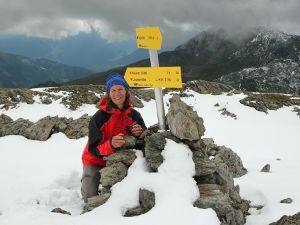 One of
Sandra's dreams was to go for a long walk one day. Like her, I had
been on many short hiking trips, lasting up to one week, but never
longer than that. So we decided to spend four weeks of our summer
holiday by walking over the Alps.
One of
Sandra's dreams was to go for a long walk one day. Like her, I had
been on many short hiking trips, lasting up to one week, but never
longer than that. So we decided to spend four weeks of our summer
holiday by walking over the Alps.
Our route was mostly following the München-Venedig trail, a 550 km hiking route from Munich, Germany to Venice, Italy. Apparently a few hundred people walk at least a part of the trail every year. The route is described with minor differences in at least three books, all in German. We were carrying two of them with us.
We skipped the first 150 km and started near Innsbruck in Austria. The first day was easy: a bus to Tulfes and a ski lift up to 2000 meters left only a few kilometers of distance and 600 meters of altitude to climb up to Glungezer hut, our first place to stay. This time we didn't carry a tent, but our backpacks were loaded with a camping cooker, food, clothes and other equipment needed for the trip.
Second day showed us the reality of the mountains: sunshine had turned into snow and clouds with almost zero visibility. We chose a route which stayed most of the time on a ridge above 2500 m, trusting the forecast which suggested weather to clear up by noon. Well, it didn't and we spent a full day doing our best to find safe steps on the slippery rocks. It was almost dark when we arrived at the next hut.
On the following day the weather was better again and we got used to the already familiar Alpine scenery: snow-capped peaks, rocky ridges, mountain lakes and grass-covered highlands where cows and sheep were grazing between the mountain flowers. A new companion we hadn't so often seen before were marmots, who were squeaking and standing on two feet besides their holes, looking at us.
The trail never climbed over 3000 meters but rarely descended below 1500 meters. The weather varied rapidly from 25°C sunshine to cold rain, with temperature occasionally falling down to 0°C and rain turning into sleet. Once we had to change our planned route: Friesenbergscharte was not passable due to too much snow and clouds. We hiked about 10 km west and crossed the ridge at Alpeinerscharte, knee deep in the fresh snow. On the way we stayed one night at Geraerhütte, which turned out to be one of the most charming huts of the whole trip.
I had usually traveled with a tent so hiking from hut to hut was something new for me. Huts in the Alps are quite well equipped, even luxurious: most have nowadays electricity, hot showers, water closets and a fully equipped restaurant. Perhaps a bit surprisingly, they are still considerably cheaper than hotels and guesthouses in the valleys, at least for Alpine club members. A bed in the dormitory costs 8-10 euros for members (about double from non-members) and meal prices are similar to simple restaurants down in the valleys.
Where the huts differ between each other is the atmosphere. Some are friendly and cozy family businesses where the hosts have time to talk with every guest personally, while others are more busy hostel and restaurant establishments. Small huts far away from roads and cable cars are usually the best. Our favourites on this hike were Geraerhütte (Austria), Kreuzwiesen Alm (Italy) and Rifugio Pisciadu (Italy).
Actually we were in Austria only the first five days before arriving in Italy. However, the main local language was German still for a week and both the mountains and architecture of houses remained similar to Austria. It took a few more days to reach the Dolomites, which looked quite different. More about them in part 2.
A taste of luxury
Posted: 2006-08-27 15:39:40, Categories: Travel, Slovakia, Austria, 592 words (permalink)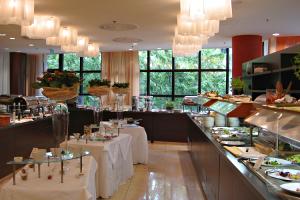 Usually I don't have problems choosing what to have for breakfast. Most often I eat some bread, cheese, youghurt, vegetables and fruits I've bought the previous day, accompanied with tea which I can prepare using my gas cooker when camping or by boiling water in the kitchen if I'm staying at a hostel. When staying in pensions or private homes I've had several breakfasts prepared for me as well, in most cases either some ready-made sandwiches or bread with a choice of cheese, cold meat products and vegetables.
Usually I don't have problems choosing what to have for breakfast. Most often I eat some bread, cheese, youghurt, vegetables and fruits I've bought the previous day, accompanied with tea which I can prepare using my gas cooker when camping or by boiling water in the kitchen if I'm staying at a hostel. When staying in pensions or private homes I've had several breakfasts prepared for me as well, in most cases either some ready-made sandwiches or bread with a choice of cheese, cold meat products and vegetables.
In Crowne Plaza Bratislava you could point out which ingredients you'd like for an omelette specially made for you, and proceed to fill your plate from an abundant selection of bread, pastries, cheese, meat, fish, cereal, vegetables, fresh fruit, puddings, you name it. If you wanted to start your morning with a glass of sparkling wine — sure, it was included — or maybe you'd go for the more usual selection of fruit juices, coffees and teas for drinks. The picture on the right shows a part of the breakfast buffet.
The three night stay in Crowne Plaza was with my mother and two brothers; my father was too busy with his work and couldn't come. We spent in total six days together, splitting the time evenly between Vienna and Bratislava. We don't usually go for the very top end accommodation and our hotel in Vienna was more modest, but in Bratislava it ended up so as a result of some other hotels being full and my family finding an acceptable price on the Internet for the more luxurious option.
The higher standard of the rooms and especially the breakfast buffet was the largest materialistic difference to my usual days when traveling. We naturally also had good dinners together in restaurants, perhaps slightly more classy ones than I mostly go to, but even when traveling alone I quite often go to a restaurant for a nice three course meal with drinks. One of my basic guidelines in both cheap and more expensive countries is to spend more money rather on food than accommodation.
The main thing during that week was naturally to meet my family members, but we also did a lot of sightseeing in Vienna and Bratislava. I've met several other travellers who didn't like Bratislava much, but I found it quite nice. For me the compactness the old town and relatively small size of the city in general (compared to many other European capitals) was appealing rather than limiting. It was also worth going a little bit out of the center to see the Devin castle, not so much for the castle but for the spectacular setting on top of a hill overlooking the Danube river.
In Vienna I didn't feel like getting a good grip of the city in three days. We went to see some magnificent buildings, like the Opera house and Schönbrunn castle, both from the outside and inside, but they remained separate and superficial experiences for me. We spent quite a few hours every day walking around in the city but I still cannot easily name a favorite spot or area there. I would probably find some if I stayed longer but the city just didn't open up immediately for someone who is not a big classical music and opera fan. One special positive thing which I must mention as a cyclist is that Vienna had a very nice city bike system. I didn't try it but both the network of pick-up/drop-off points and the bikes looked good.

Copyright Arto Teräs <ajt@iki.fi>, licensed under the Creative Commons Attribution-Share Alike 3.0 Unported License. (Unless otherwise mentioned in individual photos or other content.)
